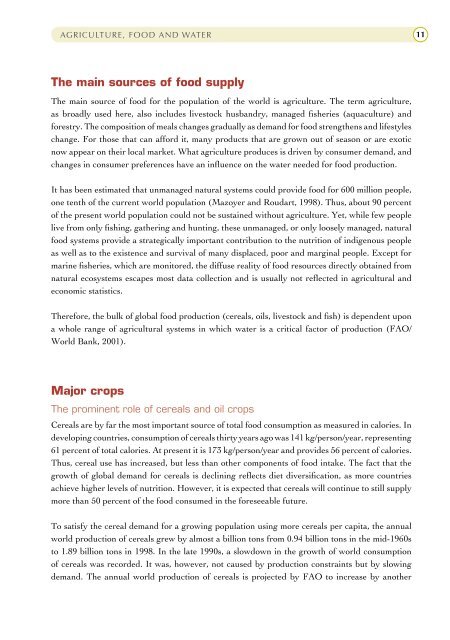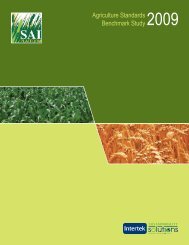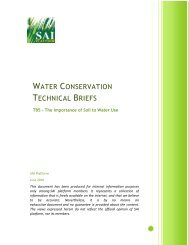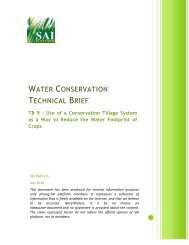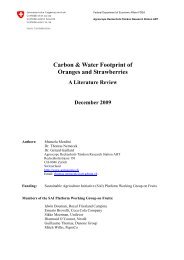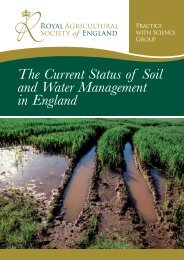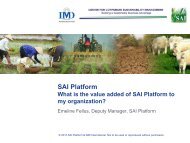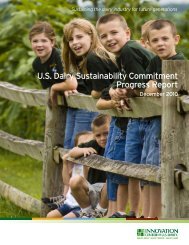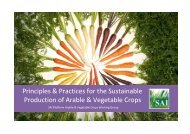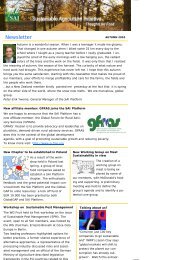Agriculture, food and water - FAO.org
Agriculture, food and water - FAO.org
Agriculture, food and water - FAO.org
Create successful ePaper yourself
Turn your PDF publications into a flip-book with our unique Google optimized e-Paper software.
AGRICULTURE, FOOD AND WATER<br />
11<br />
The main sources of <strong>food</strong> supply<br />
The main source of <strong>food</strong> for the population of the world is agriculture. The term agriculture,<br />
as broadly used here, also includes livestock husb<strong>and</strong>ry, managed fisheries (aquaculture) <strong>and</strong><br />
forestry. The composition of meals changes gradually as dem<strong>and</strong> for <strong>food</strong> strengthens <strong>and</strong> lifestyles<br />
change. For those that can afford it, many products that are grown out of season or are exotic<br />
now appear on their local market. What agriculture produces is driven by consumer dem<strong>and</strong>, <strong>and</strong><br />
changes in consumer preferences have an influence on the <strong>water</strong> needed for <strong>food</strong> production.<br />
It has been estimated that unmanaged natural systems could provide <strong>food</strong> for 600 million people,<br />
one tenth of the current world population (Mazoyer <strong>and</strong> Roudart, 1998). Thus, about 90 percent<br />
of the present world population could not be sustained without agriculture. Yet, while few people<br />
live from only fishing, gathering <strong>and</strong> hunting, these unmanaged, or only loosely managed, natural<br />
<strong>food</strong> systems provide a strategically important contribution to the nutrition of indigenous people<br />
as well as to the existence <strong>and</strong> survival of many displaced, poor <strong>and</strong> marginal people. Except for<br />
marine fisheries, which are monitored, the diffuse reality of <strong>food</strong> resources directly obtained from<br />
natural ecosystems escapes most data collection <strong>and</strong> is usually not reflected in agricultural <strong>and</strong><br />
economic statistics.<br />
Therefore, the bulk of global <strong>food</strong> production (cereals, oils, livestock <strong>and</strong> fish) is dependent upon<br />
a whole range of agricultural systems in which <strong>water</strong> is a critical factor of production (<strong>FAO</strong>/<br />
World Bank, 2001).<br />
Major crops<br />
The prominent role of cereals <strong>and</strong> oil crops<br />
Cereals are by far the most important source of total <strong>food</strong> consumption as measured in calories. In<br />
developing countries, consumption of cereals thirty years ago was 141 kg/person/year, representing<br />
61 percent of total calories. At present it is 173 kg/person/year <strong>and</strong> provides 56 percent of calories.<br />
Thus, cereal use has increased, but less than other components of <strong>food</strong> intake. The fact that the<br />
growth of global dem<strong>and</strong> for cereals is declining reflects diet diversification, as more countries<br />
achieve higher levels of nutrition. However, it is expected that cereals will continue to still supply<br />
more than 50 percent of the <strong>food</strong> consumed in the foreseeable future.<br />
To satisfy the cereal dem<strong>and</strong> for a growing population using more cereals per capita, the annual<br />
world production of cereals grew by almost a billion tons from 0.94 billion tons in the mid-1960s<br />
to 1.89 billion tons in 1998. In the late 1990s, a slowdown in the growth of world consumption<br />
of cereals was recorded. It was, however, not caused by production constraints but by slowing<br />
dem<strong>and</strong>. The annual world production of cereals is projected by <strong>FAO</strong> to increase by another


